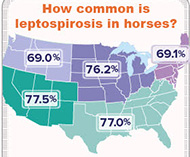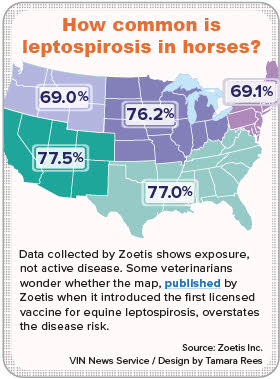

The vast majority of horses across the United States — 77 percent in some regions — have been exposed to equine leptospirosis, according to Zoetis, maker of a new vaccine to protect against the bacteria Leptospira.
"A recent study supported by Zoetis showed 75 percent of healthy horses have been exposed to at least one leptospiral serovar," report marketers, referring to the distinct subgroup of the zoonotic bacteria disease that's found in horses. "As clinical signs associated with leptospirosis are non-specific, disease in horses likely occurs more frequently than is diagnosed, and exposure to Leptospira may be more prevalent than was previously understood."
Those claims have evoked surprise and consternation among equine veterinarians, some who doubt that the zoonotic bacterial disease is so prevalent. Dr. Robert Rogers, an equine veterinarian in Spring, Texas, wonders whether Zoetis is exaggerating equine exposure risks to drive sales of Lepto EQ Innovator. Introduced last fall, Lepto EQ Innovator is the first U.S. Department of Agriculture-approved vaccine specifically labeled to help prevent leptospirosis caused by Leptospira pomona.
"Leptospirosis is hard to detect. Now helping prevent it can be easy," the Zoetis advertisement says.
Rogers shared concerns about Zoetis’s marketing claims on a message board of the Veterinary Information Network, an online community for the profession. In 2014, Zoetis funded serologic studies on 5,261 healthy horses, most of which tested were positive for exposure to Leptospira. Exposure rates ranged from 69 percent in the Pacific Northwest to 77.5 percent in the West and Southwest, according to a Zoetis map.
"I question the results," Rogers wrote on VIN.
Dr. Kate Hepworth-Warren, a VIN consultant who’s board-certified in equine internal medicine, responded initially with similar concerns, that positive tests for leptospirosis, commonly referred to as lepto, do not always indicate disease.
"... There are a few studies looking at horses testing positive to lepto, but does this mean that they have disease? Generally not," Hepworth-Warren said last spring in the VIN discussion. "I'm still not convinced that lepto is a big enough problem in horses to warrant a vaccine."
Six months and one conference later, Hepworth-Warren is rethinking whether the disease is, in fact, prevalent enough to warrant immunization. During the American College of Veterinary Internal Medicine Forum in July, Hepworth-Warren attended renowned large animal internist Dr. Thomas Divers's lecture titled, "Leptospirosis: An Important Infectious Disease in Horses." Divers characterized the bacterium as "highly invasive."
Hepworth-Warren reflected on her evolving perspective by email, stating that leptospirosis might, in fact, be a "real problem" for equine populations. "I may have to do a bit more research," she stated.
Frequently cited as a potential cause of kidney disease in dogs and abortion in cattle, leptospirosis is something of a mystery in the horse world. The bacteria is shed in the urine of infected animals, such as raccoons and skunks.
Experts such as infectious disease specialist Dr. Scott Weese pause when discussing the impact of the bacteria in horses.
"We don’t know a lot about it. That’s the problem," said Weese, a professor at the University of Guelph Ontario Veterinary College. "It’s one of those things that could be a really common cause of disease or really rare."
Exposure to or even infection by a bacteria or virus doesn’t always result in clinical disease. The immune system may keep the pathogens from multiplying in the body to infectious numbers. Even when an animal becomes infected, its body may fight off the infection before significant signs of illness appear. In the same way that not everyone exposed to the influenza virus will develop the flu, and not everyone who gets sick will be sick to the same degree, not every animal exposed to leptospirosis will develop signs of illness.
Rogers, the Texas veterinarian who's skeptical of Zoetis's numbers, noted that apart from the incidence of abortions, equine leptospirosis is a self-limiting disease. "Horses get infected and show no symptoms or sometimes just a mild fever and then get over it, usually without the owner ever noticing," he said by email.
That leptospirosis causes disease in some horses isn't disputed. Conditions attributed to Leptospira pomona, one of more than 200 serotypes of Leptospira, include late-term abortions, kidney disease and equine recurrent uveitis (ERU), which is a chronic inflammatory condition that can lead to blindness. The tricky part in research, Weese said, is determining how many horses actually develop disease in response to leptospirosis.
Dr. Jacqueline Boggs, a senior veterinarian at Zoetis, suspects the disease is more widespread than some experts believe. "We found no statistical difference between regions across the country. It’s similar to (leptospirosis in) dogs," she said.
"We thought of it as an Eastern problem, but in canines, the more they're looking, they're seeing it all across the United States," she said. "Is it spreading or are we just testing more?" She points out that while Eastern states may have greater rainfall, which has been presumed to contribute to the spread of the bacteria, even arid regions experience conditions that produce standing water. "When it comes down to where animals are exposed, they are exposed via water and wildlife. Even in arid areas you have flood irrigation," she said.
Hepworth-Warren, the VIN consultant, said she rarely crosses paths with leptospirosis: "I’ve never diagnosed anything with leptospirosis [while] practicing in the Midwest and on the East coast."
She acknowledges that her experience doesn't mean leptospirosis doesn't exist at levels Zoetis suggests, but questions the drug maker's decision to develop a vaccine based on numbers of horses exposed to the bacteria, rather than on numbers of infected or ill horses.
Weese puts it this way: "Exposure isn't disease. Figuring out whether exposure leads to disease is the challenge."
Boggs concurs that differentiating exposure from disease is complex. She said Zoetis's data measured exposure only, as differentiating exposure from disease prevalence is only one piece of the picture. Developing the vaccine took more than a decade, Boggs said, adding that the company had been approached by researchers, clinicians and diagnosticians who were concerned about a lack of treatment options for conditions caused by leptospires, abortions in particular.
"We know how hard it is to prevent exposure to wildlife, standing water, cattle and dogs; therefore, vaccination really is ideal for prevention," she said.
To create the Zoetis map, blood samples were taken from more than 5,000 horses by 53 veterinary clinics in 18 states. "We tried to get as good cross-country distribution as we could," Boggs said. "We asked practitioners to sample 100 presumed healthy horses in practice, but no more than 10 horses per facility."
Given that contaminated water is a known point of exposure, researchers didn’t want a disproportionate number of horses coming from the same stable where they could have been exposed via the same water. The researchers also excluded horses that had been vaccinated with off-label leptospirosis vaccine, such as vaccine for dogs or cattle, within the last two years.
While previous studies of leptospirosis seroprevalence considered a horse exposed if it had an antibody level of 1:200 or greater, the Zoetis exposure benchmark was less stringent. The map of positive exposures includes all horses in the study with antibody titers of 1:100 or higher. This lower cutoff was designed to make the study as inclusive as possible, said Boggs, "to get an idea of exposure."
Exposure, according to Weese, "probably varies by area; it certainly varies by study. Presumably there are large regional variations based on the type, prevalence and exposure to wildlife."
Some veterinarians aren’t concerned that Zoetis might be overstating numbers of positive cases. Dr. Fairfield Bain, a clinical professor of equine internal medicine at the Washington State University College of Veterinary Medicine, said he saw a lot of lepto-positive horses while practicing in central Kentucky, and encountered "routine numbers" of abortions due to infection.
"I can recall one farm where we had a barn with mares aborting, a couple cases of uveitis, and a weanling with acute renal disease — all with high-positive titers to leptospirosis," he said in the VIN discussion. "In places like that where the losses are significant, I think the vaccine should be very helpful."
Lepto EQ Innovator is recommended as an initial two-dose series spaced three to four weeks apart with annual boosters. The vaccine is approved for use in healthy horses six months or older, based on efficacy data. Boggs said that Zoetis also performed field safety studies on foals as young as two to three months. "So it’s safe in younger foals, but efficacy is based on 6 months or older," she said. "It’s safe in pregnant mares. At the time of the launch, we had enough data to say that it is safe in second-trimester mares. That is when we recommend it be used in pregnant mares anyway, since abortion is known to occur in late pregnancy."
The vaccine label doesn’t claim it will specifically prevent any of the three disease conditions associated with leptospirosis. Instead the product literature states it "helps prevent infections of the blood caused by L. pomona, which could, but has not been demonstrated to, help reduce the potential risk of equine recurrent uveitis infections, abortions and acute renal failure caused by L. pomona."
Rogers expressed concern that the vaccine could trigger the ophthalmic disease ERU, given that horses previously exposed to leptospirosis can develop an autoimmune response that causes inflammation in the eye.
"I can certainly see a need for a Lepto vaccine in a breeding situation where documented abortions caused by lepto are a problem. But for the average back yard horse, I question this," he said by email. "...Would a reasonable client, if given the facts about lepto in horses, elect to vaccinate (outside of a breeding situation)? I think not."
So far, Zoetis hasn't seen any instances of ERU during vaccine testing or administration, Boggs said.
The vaccine's benefit, she added, is a no-brainer. "There is no treatment for abortion or ERU, so protection relies on prevention," she said.
Hepworth-Warren is as yet unconvinced. "The jury is still out for me," she said.